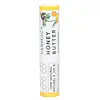What's inside
What's inside
 Key Ingredients
Key Ingredients

 Benefits
Benefits

 Concerns
Concerns

No concerns
 Ingredients Side-by-side
Ingredients Side-by-side

Ricinus Communis Seed Oil
MaskingOlea Europaea Fruit Oil
MaskingCocos Nucifera Oil
MaskingSimmondsia Chinensis Seed Oil
EmollientCera Alba
EmollientEuphorbia Cerifera Wax
Helianthus Annuus Seed Oil
EmollientCopernicia Cerifera Wax
Theobroma Cacao Seed Butter
EmollientTheobroma Grandiflorum Seed Butter
Skin ConditioningTocopherol
AntioxidantSqualane
EmollientEchinacea Purpurea Root Extract
MoisturisingHoney Extract
HumectantPropolis Extract
Skin ConditioningRoyal Jelly Extract
Skin ConditioningCananga Odorata Flower Oil
MaskingCitrus Limon Peel Oil
MaskingCitrus Aurantium Bergamia Fruit Oil
MaskingCitral
PerfumingLimonene
PerfumingLinalool
PerfumingRicinus Communis Seed Oil, Olea Europaea Fruit Oil, Cocos Nucifera Oil, Simmondsia Chinensis Seed Oil, Cera Alba, Euphorbia Cerifera Wax, Helianthus Annuus Seed Oil, Copernicia Cerifera Wax, Theobroma Cacao Seed Butter, Theobroma Grandiflorum Seed Butter, Tocopherol, Squalane, Echinacea Purpurea Root Extract, Honey Extract, Propolis Extract, Royal Jelly Extract, Cananga Odorata Flower Oil, Citrus Limon Peel Oil, Citrus Aurantium Bergamia Fruit Oil, Citral, Limonene, Linalool
Diisostearyl Malate
EmollientCapryloyl Glycerin/Sebacic Acid Copolymer
Skin ConditioningBis-Diglyceryl Polyacyladipate-2
EmollientGlycerin
HumectantHydroxystearic/Linolenic/Oleic Polyglycerides
EmollientMyristic/Palmitic/Stearic/Ricinoleic/Eicosanedioic Glycerides
Skin ConditioningRicinus Communis Seed Oil
MaskingSqualane
EmollientWater
Skin ConditioningRosa Damascena Flower Wax
MaskingCeramide NP
Skin ConditioningHydrolyzed Jojoba Esters
Skin ConditioningVitis Vinifera Seed Oil
EmollientUndaria Pinnatifida Extract
Skin ConditioningCaprylic/Capric Triglyceride
MaskingTetrahexyldecyl Ascorbate
AntioxidantSodium Hyaluronate
HumectantJojoba Esters
EmollientTocopherol
AntioxidantHydrogenated Castor Oil
EmollientGlyceryl Caprylate
EmollientGlyceryl Undecylenate
EmollientDextrin Palmitate
EmulsifyingDiisostearyl Malate, Capryloyl Glycerin/Sebacic Acid Copolymer, Bis-Diglyceryl Polyacyladipate-2, Glycerin, Hydroxystearic/Linolenic/Oleic Polyglycerides, Myristic/Palmitic/Stearic/Ricinoleic/Eicosanedioic Glycerides, Ricinus Communis Seed Oil, Squalane, Water, Rosa Damascena Flower Wax, Ceramide NP, Hydrolyzed Jojoba Esters, Vitis Vinifera Seed Oil, Undaria Pinnatifida Extract, Caprylic/Capric Triglyceride, Tetrahexyldecyl Ascorbate, Sodium Hyaluronate, Jojoba Esters, Tocopherol, Hydrogenated Castor Oil, Glyceryl Caprylate, Glyceryl Undecylenate, Dextrin Palmitate
 Reviews
Reviews

Ingredients Explained
These ingredients are found in both products.
Ingredients higher up in an ingredient list are typically present in a larger amount.
Ricinus Communis Seed Oil is the INCI name for castor oil.
Castor Oil helps moisturize the skin. It is rich in a fatty acid called ricinoleic acid. This fatty acid helps prevent moisture loss on the skin. This helps keep your skin soft and hydrated. Ricinoleic acid also has anti-inflammatory and pain reducing properties.
Besides hydrating the skin, castor oil is also used to hydrate hair. By keeping the hair shaft moisturized, breakage is decreased. More studies are needed to show castor oil's effective on stimulating hair growth.
Castor oil is created by cold-pressing castor seeds and then purifying the oil with heat. It was used in Ancient Egypt as fuel in lamps and to help treat eye irritation.
The term 'fragrance' is not regulated in many countries. In many cases, it is up to the brand to define this term. For instance, many brands choose to label themselves as "fragrance-free" because they are not using synthetic fragrances. However, their products may still contain ingredients such as essential oils that are considered a fragrance.
Learn more about Ricinus Communis Seed OilSqualane is an emollient that helps the skin hold onto moisture. It's an oily liquid that occurs naturally in certain types of fish and plant oils.
Because squalane boosts hydration in the skin, it also comes with plenty of benefits: it is an antioxidant and can help fight free radicals and skin damage. Squalane is also found to have a detoxifying effect when applied.
Squalane comes from squalene, which occurs naturally within the sebum of our skin. It is one of the oils our skin produces to keep itself hydrated. Squalane is the hydrogenated version of squalene and has a longer shelf life.
Research shows that squalane is non-irritating (even at 100% concentration).
In general, it's a fantastic ingredient. It does a great job at hydrating the skin, and it's suitable for those with sensitive skin.
The source of squalane may impact malassezia / fungal acne. This is because olive oil derived squalane can contain impurities such as fatty acids and plant waxes. Sugarcane derived squalane is recommended for anyone with malassezia concerns.
Is squalane vegan?
This depends on the source. Squalane can be derived from both plants and animals. Most squalane used in skincare comes from plants.
Please note: the source of squalane is only known if disclosed by the brand. We recommend reaching out to the brand if you have any questions about their squalane.
Read more about squalene with an "e".
Is squalane an oil?
Squalane is often called an oil, but it’s technically not; it’s a hydrocarbon, meaning it’s only made of carbon and hydrogen, unlike true oils which are triglycerides made of fatty acids and glycerol.
The term “oil-free” isn’t regulated, so companies can define it however they want. Some exclude all oils, while others just avoid mineral oil or comedogenic oils.
While some people avoid oils thinking they cause breakouts, the right kind of oil (or oil-like ingredient like squalane) can actually help balance and hydrate your skin. It’s worth testing out simple oils or squalane to see what works best for your skin.
Learn more about SqualaneTocopherol (also known as Vitamin E) is a common antioxidant used to help protect the skin from free-radicals and strengthen the skin barrier. It's also fat soluble - this means our skin is great at absorbing it.
Vitamin E also helps keep your natural skin lipids healthy. Your lipid skin barrier naturally consists of lipids, ceramides, and fatty acids. Vitamin E offers extra protection for your skin’s lipid barrier, keeping your skin healthy and nourished.
Another benefit is a bit of UV protection. Vitamin E helps reduce the damage caused by UVB rays. (It should not replace your sunscreen). Combining it with Vitamin C can decrease sunburned cells and hyperpigmentation after UV exposure.
You might have noticed Vitamin E + C often paired together. This is because it is great at stabilizing Vitamin C. Using the two together helps increase the effectiveness of both ingredients.
There are often claims that Vitamin E can reduce/prevent scarring, but these claims haven't been confirmed by scientific research.
Learn more about Tocopherol